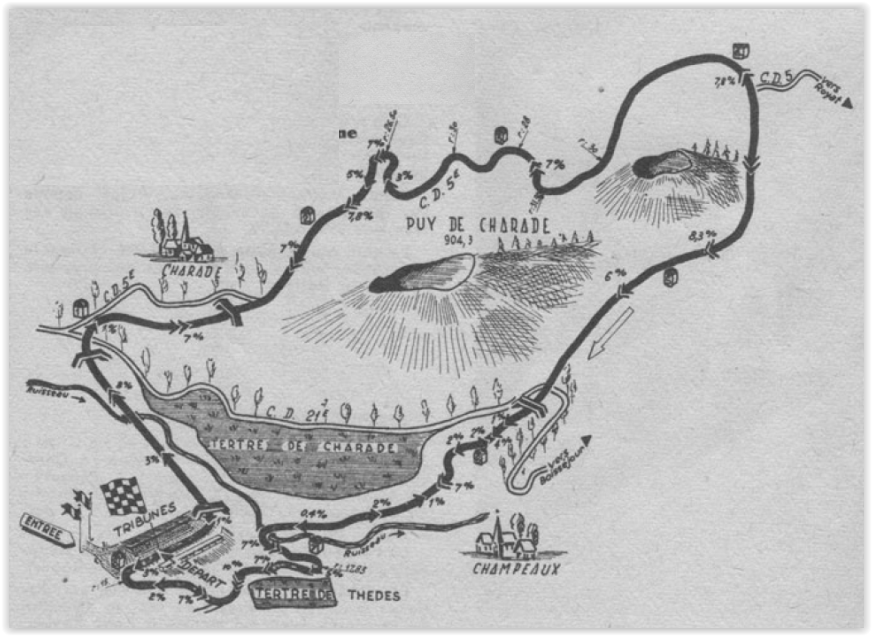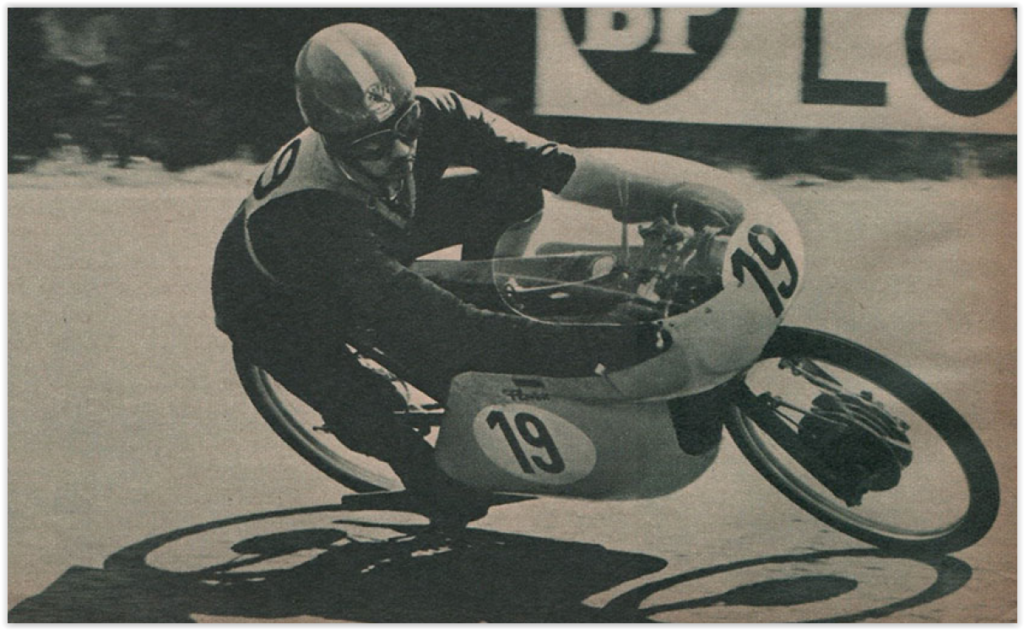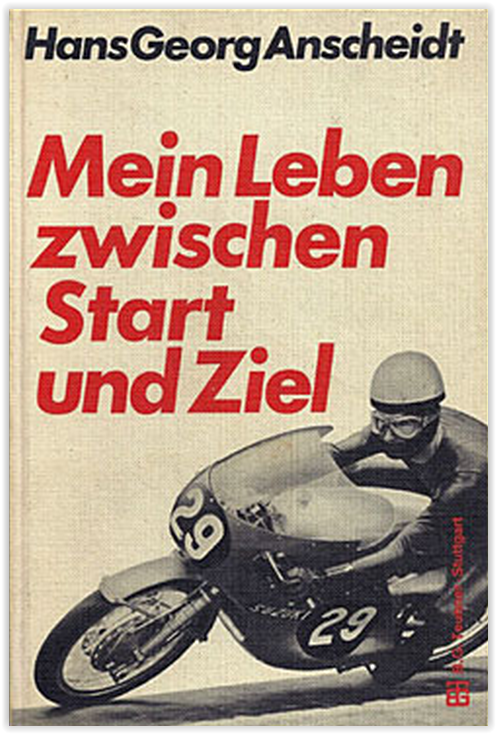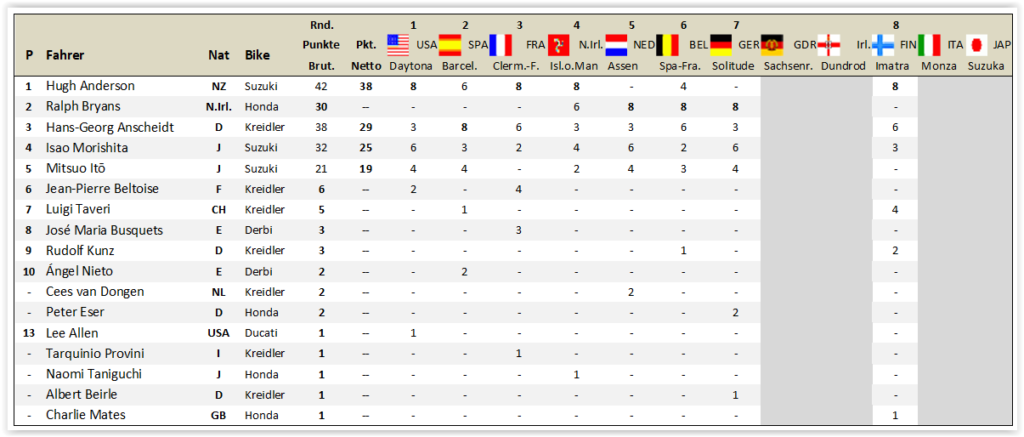
The 1963 season – a perfect start for Anscheidt
In the international race for the “Price of the Saarland” in April in Sankt Wendel, Anscheidt came second behind Degner. And after the victorious start at the Grand Prix season opener in Montjuic Park for the Barcelona GP, he won hist homerace on the Eifelrace at the Nürburgring.



Less success at home GP
Things went less well at the Hockenheimring at the home race. It was won by Suzuki driver Hugh Anderson, ahead of his brand colleagues Isao Morishita and Ernst Degner.


Grand Prix of France
Hans Georg then won the French GP in Clermont-Ferrand and, like in Barcelona, again set the fastest race lap. Ernst Degner was second ahead of his Japanese teammate Michio Ichino and the Spaniard José Maria Busquets on Derbi.



The TT adventure and Grand Prix of the Netherlands
After 3rd place at the GP at the infamous Isle of Man TT race behind the Japanese Ito and Anderson (both Suzuki), it wasn’t enough for a top result at the Assen GP. Of course, the German was not satisfied with rank 6.



The exemplary fighter from Germany at the Grand Prix of Belgium
The next round was the GP of Spa-Francorchamps in Belgium. Anscheidt was unlucky and was slowed down in the race by a clutch defect. But the little fighter with the big heart did not give up and as soon as he brought his engine back up to speed, he drove his opponents up and away again. The German even drove the fastest lap of the race and, despite a considerable handicap, still secured 3rd place.



The Grand Prix race in the north of Europe
The Finnish GP in Tampere was a sure prey for the Prussians from Königsberg. Anscheidt won his third race of the season and had more victories than any of his competitors in the 50cc class this year.

The botched season finale cost him the title
After failing to make it onto the podium in the last two races in Argentina and Japan, however, he lost two points to Hugh Anderson in the World Championship final classification. The New Zealander even became double world champion over 50 and 125cc for Suzuki this season. Third place in the World Championship was ex-GDR pilot Ernst Degner, 2 points behind Hans Georg Anscheidt.



The 1963 World Championship
After the runner-up title in the previous year, H. G. Anscheidt succeeded in repeating this result in 1963. This time behind the new World Champion Hugh Anderson from New Zealand and Degner came third.

The 1964 season

Ernst Degner injured – renouncing the 50 World Cup
Due to a horror accident in the final race of the Japanese GP in 1963 in Suzuka, Enrst Degner sustained severe burns. For this reason, the Suzuki works driver from the GDR had to take a longer break and was only able to intervene again at the end of the 1964 season. He concentrated on the 125 class and took 3rd place in the penultimate race in Monza. In the final in Suzuka it was even enough to win.


Even without Degner it was not becoming easier for Hans Georg
The problems did not get any smaller for H. G. Anscheidt, because Honda was also making more and more efforts in the smaller classes. In addition, Suzuki still had 3 hot irons in the fire with world champion Hugh Anderson (NZL), Isao Morishita and Mitsuo Itoh (both Japan). It was in this order that these three won the season opener for the US GP in Daytona.

Revenge at the season opener in Europe
Anscheidt struck back at the Spanish GP in Barcelona’s Montjuic Park and won the second race of the season. He also set the fastest race lap and only had to admit defeat Hugh Anderson on lap 3. With 11 points, Anscheidt was now second behind Anderson (with 14) in the 50cc World Championship.


At the Tourist Trophy on the Isle of Man
After the French GP, it went back to the Isle of Man. After a good start, Anscheidt was in third place behind Anderson and Itoh after the first of 3 laps. From the second lap the German crossed the finish line in 2nd place, but fell back to 4th place in the last lap. Although he was measured with the highest top speed of 164.2 km/h (102 mph), Hans Georg could not really get used to the end result. At the TT race on the Isle of Man, one lap was around 60 km long. The average speed of the 50cc racing fleas of almost 130 km/h (80,77 mph) was quite impressive.



The hapless second half of the season for H. G. Anscheidt
While in the middle class up to 250cc, just like in the 125cc, the World Cup was held over 11 rounds, in the 50cc category and the 500s there were only nine. For the 350s category there were 8 laps in 1964. At the Dutch TT in the 4th round of the World Championship in Assen, it was not enough for H. G. for a podium. In Spa-Francorchamps at the Belgian GP it was second behind Honda works driver Ralph Bryans and ahead of Hugh Anderson. The Englishman also won round 7 of Anscheidt’s home GP at the Solitude. Anderson and Anscheidt were not represented on the podium. While Hugh Anderson made the second zero of the season, Hans Georg scored 3 points with 4th place.

Anderson secured the title defense
In the penultimate round in the calendar in Imatra for the Finnish GP, Anderson made his 4th victory in the 1964 season. Hans Georg Anscheidt was second in Finland and had 38 World Cup counters in his account. In the end, however, the most consistent driver of the season (along with Morishita) was cut off 9 points due to the regulations at the time. This caused him the loss of the runner-up title to the Englishman Ralph Bryans, who crossed the finish line only 3 times as winner and once in second place. The Honda works driver at 30 years of age as a result of those regulations, made one point more than the German.

World Championship status 1964 according to the rating at the time
There were 9 races planned for this season, but only 8 of them, not counting the Japanese GP. Before the race, Suzuki withdrew its 7 factory drivers, leaving only 5 remaining Honda drivers to start. It was won by the Northern Irishman Ralph Bryans ahead of Luigi Taveri (Switzerland) and the Japanese Taniguchi. For this reason, the race was not rated for the World Championship. Finished in 7th to 10th place, but not listed due to the evaluation criteria for World Championship points at the time, the following pilots were also in the 1964 season:
Raymond Bogaerdt (B, Honda), Jean-Claude Cachou (F, Derbi), Daniel Crivello (F, Derbi), Herbert Denzler (CH, Kreidler), Volker Kramer (D, Eigenbau), Jim Pink (GB, Honda), Ian Plumridge (GB, Honda), André Roth (CH, Tohatsu), Matti Salonen (SF, Prykija), Dave Simmonds (GB, Tohatsu), Gerhard Thurow (D, Kreidler), Pierre Viura (F, Derbi).

World Cup status according to today’s rating – interesting result
Instead of missing out on the runner-up title by one point, the German would have even got the world champion point based on today’s rating. This after a little game of numbers with an award according to the current FIM regulations. At that time, persistence was anything but rewarded. At that time only the 5 best results were evaluated, so that H. G. Anscheidt could only benefit financially from his regular arrival at the finish line. Compared to today, however, the prize money in the 60s was ridiculous.
Today Anscheidt would have the vice world championship title

Significantly higher risk of injury
Almost everywhere there was a lack of adequate fall spaces and guardrails were mostly only “secured” with bales of straw until well into the 1980s. Full face helmets and back protectors were just as rare as safety clothing. In the earlier decades of motorcycle racing, technology was also partly responsible for many falls, for example as a result of connecting rods breaking or piston jamming at full speed. As at rally events, spectators often stood directly on the track. In 1964, 5 GP drivers lost their lives in racing accidents. In our international statistics, including national events, there were at least eight of them.


No Comments Yet